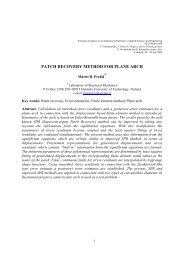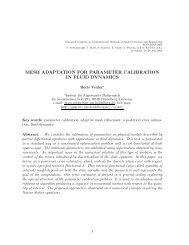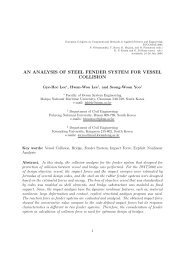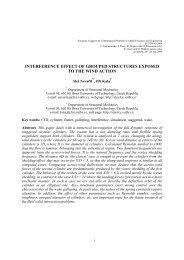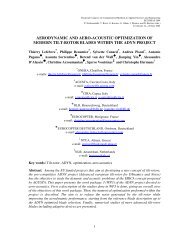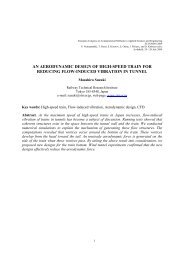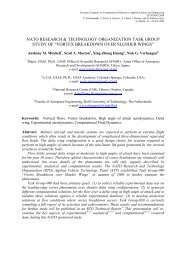Aerodynamic Design of Unmanned and Scaled Supersonic ...
Aerodynamic Design of Unmanned and Scaled Supersonic ...
Aerodynamic Design of Unmanned and Scaled Supersonic ...
You also want an ePaper? Increase the reach of your titles
YUMPU automatically turns print PDFs into web optimized ePapers that Google loves.
K. Yoshida <strong>and</strong> Y. Makino<br />
minimum pressure drag characteristics were<br />
estimated over the whole Mach number range as<br />
shown in Figure 17. We made best use <strong>of</strong> the nonaxisymmetrical<br />
area-ruled body concept <strong>and</strong><br />
obtained remarkable improvement in aerodynamic<br />
performance. Consequently, the “2.5th<br />
Configuration” was selected as the final<br />
aerodynamic configuration for the NEXST-2<br />
airplane.<br />
2.0th Configuration<br />
2.5th Configuration<br />
3.3 Wind Tunnel Tests<br />
Figure 17. Minimum pressure drag <strong>of</strong> NEXST-2<br />
To underst<strong>and</strong> the strong airframe/nacelle<br />
interference completely, <strong>and</strong> to develop the reliable <strong>and</strong> effective database for supersonic<br />
intake, several wind tunnel tests were conducted [22-24, 26-27]. In this section, principal<br />
results on fundamental research activity except intake tests are summarized below.<br />
1) CFD validation tests <strong>of</strong> the airframe/nacelle<br />
interference configuration model<br />
The test model <strong>of</strong> the “0-8th Configuration” with<br />
flow-through-nacelle was used to conduct the CFD<br />
validation for a complicated configuration with<br />
nacelles. Figure 18 shows the force test model with a<br />
modified intake shape <strong>and</strong> a CFD grid. The scale <strong>of</strong><br />
the test model was 8.3% <strong>of</strong> the NEXST-2 airplane.<br />
Both supersonic <strong>and</strong> subsonic tests were conducted at<br />
JAXA [26]. In the test at flow-through-nacelle<br />
condition, the drag measured by a force balance<br />
should be corrected using the relation <strong>of</strong> momentum<br />
balance <strong>of</strong> internal flow <strong>of</strong> the nacelle.<br />
Figure 19 shows measured <strong>and</strong> corrected drag<br />
polar curves, comparing them with CFD(NS)<br />
computation results. An open circle <strong>and</strong> triangle<br />
symbols indicate test results <strong>of</strong> drag characteristics<br />
without <strong>and</strong> with the internal flow correction<br />
respectively. Our CFD computation results on both<br />
conditions without <strong>and</strong> with the internal flow<br />
correction are fairly smaller than those <strong>of</strong> the test<br />
results. It strongly depends on the turbulence model in<br />
our CFD code. If we assumed the drag characteristics<br />
with an <strong>of</strong>f-set value 0.0049 <strong>of</strong> the minimum drag, we<br />
found very high correlation between those assumed<br />
5.06 million points:<br />
supersonic flow case<br />
Figure 18. W/T model & CFD grid <strong>of</strong><br />
“0-8th configuration”<br />
0.01 0.02 0.03 0.04 0.05 C D<br />
drag polar curves <strong>and</strong> test results. Therefore, the pressure drag characteristics estimated by the<br />
CFD code were well validated.<br />
CL<br />
0.4<br />
0.3<br />
0.2<br />
0.1<br />
0<br />
-0.1<br />
NEXST-2-08 : Wing+Body+Nacelle<br />
M=1.7<br />
No Int. Correc.<br />
With Int. Correc.<br />
BWT(20099) NS Off-set(0.0049)<br />
Figure 19. Comparison <strong>of</strong> test <strong>and</strong> CFD<br />
results<br />
17



